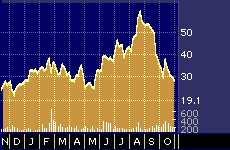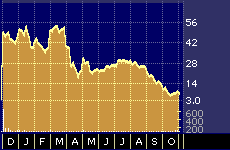
Is McAfee the Play in Anti-Virus Stocks?
Is McAfee the Play in Anti-Virus Stocks?
By Hal Plotkin
CNBC.com Silicon Valley Correspondent

001110symantec
Symantec 52-week stock price
Between PC virus scares, most investors probably don’t pay too much attention to the stocks of firms that sell virus-protection software. But when a scare does occur, you can usually count on a spike in the shares of the most popular anti-virus firms.
Take a look, for example, at what happened to Symantec Corp.’s {SMTC}’s stock last May after the I Love You virus hit.
Investors who want to get ready for the next spike would be wise to catch up on the progress made by Symantec’s competitor, Network Associates Inc.’s {NETA} spinoff, McAfee.com Inc. {MCAF}.
Network Associates spun off MacAfee.com into a separate entitity in 1998 to raise capital and to let McAfee focus on competing more directly with Symantec’s popular Norton anti-virus products. Network Associates retains an 83% ownership stake in the firm, which went public in December 1999.
Network Associates is the leading seller of corporate online security solutions for three years running, capturing 47% of the market last year, according to a report released on Thursday by International Data Corp.
But McAfee.com rival Symatec’s Norton line of anti-virus products has long led the retail consumer anti-virus segment. In 1999, revenues from Symantec’s Norton anti-virus products grew by 27%, year over year, as compared with just 6% year over year revenue growth for Network Associates’s McAfee.com, according to IDC.
During the month before the I Love You virus hit, for example, Symantec sold 99,103 copies of its flagship Norton Anti-Virus product through retail stores compared with 48,043 for McAfee.com, according to PC Data, based in Reston, Virginia.

001110mcafee
McAfee 52-week stock price
The sales figures do not, however, include online sales made directly by the companies, an increasingly important distribution method for MacAfee.com.
The news is significant for investors because it sets the stage for a possible recovery of McAfee.com’s ailing stock.
Norton’s lead is eroding, in part, because previous versions of its anti-virus software are not compatible with Microsoft’s latest consumer PC operating system. Moreover, McAfee’s current anti-virus product, which uses Microsoft Corp.’s {MSFT} ActiveX technology, also eliminates many of the hassles involved with using previous iterations of its own and competing products.
That may help explain why McAfee.com has picked up roughly 650,000 new subscribers over the past twelve months, 150,000 of whom signed up for the $29.95 yearly subscription service during the most recent quarter, which ended September 30.
“It took the Wall Street Journal four years to crack 500,000 [paid online] users,” crows Doug Cavit, McAfee.com’s chief information officer. “We’ve done 650k is just one year.”
The overall market for anti-virus products is estimated at $1.2 billion this year and is projected to grow to $2.7 billion by 2004, according to IDC, representing an annual growth rate of approximately 17%.
But McAfee’s segment of that market is expect to grow particulary fast.
Anti-virus solutions delivered via the application service provider (ASP) channel, which enable instantaneous updates over the Internet, should grow by 105% a year between now and 2004, topping more than half a billion dollars in sales by the end of that period, according to IDC.
Both Norton and McAfee’s products let users update their virus definitions automatically over the Internet. McAfee.com’s current product, however, offers the added advantage of automatic updates of user computers whenever new virus threats emerge. Norton users, by contrast, create a schedule that tells their computer when to check for software updates and can also be notified when their systems are no longer up to date.
“Ease of use is very important for anti-virus products,” says Brian Burke, research director for Internet security at International Data Corporation, based in Framingham, Massachusetts. “The key is to make the software almost transparent to the users.”
The analysts say that’s exactly what McAfee.com has done, in part, by becoming the first anti-PC virus company to offer a web-based service that takes advantage of Microsoft’s {MSFT} ActiveX technology. The technology, which is in some ways similar to Sun Microsystem’s JAVA software, enables software applications to be run on a wide variety of different machines with fewer installation headaches or system conflicts.
More important, McAfee.com’s anti-virus software is fully compatible with all of Microsoft’s Windows consumer PC operating systems, including Windows 98 and the newer Windows Millennium, or Windows ME, edition.
Rival Symantec’s pre-existing and market-leading flagship product, Norton Anti-Virus 2000, by contrast, is not compatible Microsoft’s Windows ME operating system. In September, Symantec introduced an update called Norton Anti-Virus 2001, which it says is fully compatible with Windows ME. Customers who purchased Norton’s 2000 anti-virus product, which first became available a little over a year ago, were recently invited to purchase the required upgrade for an additional $27.49.
|
||||||||||||||
But when CNBC.com recently tested versions of both products we encountered difficulties booting up a PC running Windows ME with either the 2000 or 2001 versions of Norton’s anti-virus products, both of which worked flawlessly on previous versions of Windows. Calls to technical support at Microsoft Corp. resulted in advice to remove the Norton anti-virus software from the Windows ME system, which then ran without any further problems.
“Anti-virus 2000 is not compatible with Windows ME,” acknowledges Laura Garcia-Manrique, Norton’s Anti-Virus 2001 product manager. “But we have not seen those issues reported to us by any of our customers with [Norton anti-virus] 2001.”
Which is a little odd, because I, for one, personally reported those exact problems to Norton’s customer service department via fax and email when I encountered them late last month. The company responded to those complaints by promptly refunding the purchase price.
The Norton product manager also says computers shouldn’t fail to boot up even if they’re loaded with Symantec software that is not compatible with Microsoft’s latest operating system.
Symantec does not, however, offer free telephone support for any users encountering installation difficulties. Instead, the firm offers users the chance to pay extra, either per minute or per incident, for installation assistance if they can’t find the help they need on the company’s web site.
It’s unclear, however, how many Norton customers will be willing to pay extra to get the help needed to install a product they’ve already paid for.
“Plug and play is the only way to go and McAfee has that all figured out,” says Richard Williams, an analyst at Jefferies & Company, based in New York. “Easy compatibility with the most popular operating systems is very important to the mass market.”
Williams is something of a lone eagle on McAfee.com’s stock. He’s the only analyst tracking the stock who stuck with his “buy” rating after the company’s warned in October that it was reducing revenue expectations due to a drop off in dot com online ad sales.
Williams did, however, lower his 12-month price target from $60 to $20, saying the move was needed to reflect changes in market sentiment regarding appropriate Internet stock valuation levels.
“The stock is very undervalued right now and a tremendous investment opportunity,” he says. “The truth is I really think it should be in the high 20’s to low 30’s.”
In October, McAfee.com officials said they would begin outsourcing online ad sales in order to place more emphasis on generating the subscriber revenue that is at the heart of the firm’s current business strategy. The company also plans to continue to offer additional products to subscribers of its web-based anti-virus service.
The operating system compatibility issue will be particularly important, say the analysts, as greater numbers of home and small business PC users migrate from Windows 98 to Windows ME. As new Windows ME users encounter difficulty with pre-installed versions of previous Norton Anti-Virus products they’re liable to give McAfee.com’s newly competitive anti-virus offering a first or second look.
“It means Norton hasn’t got its customers locked in,” says Williams. “That’s good news for McAfee.com.”
Cavit, the McAfee.com CIO, says his company is taking the fullest possible advantage of its current opportunity. He notes that 70% of the company’s active and eligible users renewed their subscriptions in September, the first month when renewals were possible. Symantec Corp., by contrast, did not provide CNBC.com with its most recent customer subscription renewal rates prior to the deadline for this story although a company spokesperson did promise to see if such data could be made available.
If Symantec seems unfazed by the McAfee challenge, it has some justifcation. This is a company that has withstood repeated challenges by upstarts and has remained on top.
“Eight or nine years ago there were maybe 40 different competitors,” he says. “But it’s the ones who can get the money to keep up to date, the ones who can invest in R&D, that will do the best. Clearly we have an aspiration to keep doing that into the future.”
But at the moment, Jefferies & Company analyst Williams says McAfee.com has cracked open a window of opportunity that should let it steal away customers who generate the annual recurring revenue stream most online operations covet.
“The first mover advantage is very important,” agrees Burke, of IDC. “A lot of customers are looking for that.”


